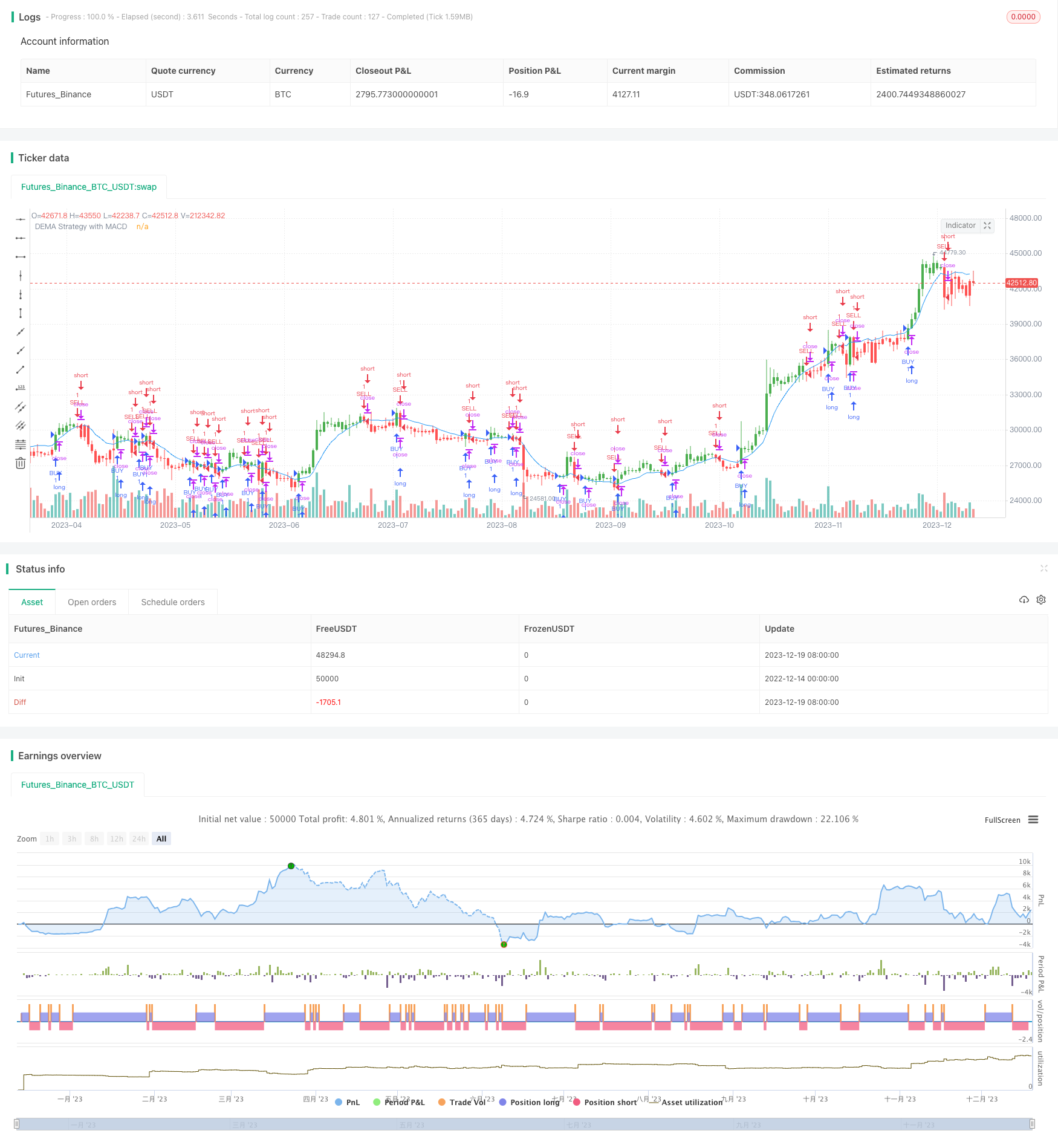
概述
本策略名称为DEMA MACD组合策略。它结合了DEMA均线指标和MACD指标,利用双指标确认进行买卖信号发出。其主要思想是同时利用趋势指标DEMA和动量指标MACD进行多重确认,通过提高信号准确度来获得更好的策略表现。
策略原理
该策略主要基于DEMA均线指标和MACD指标的组合使用。具体原理如下:
计算21日DEMA均线,当收盘价上穿DEMA均线时视为买入信号,下穿DEMA均线时视为卖出信号。
计算MACD指标的差值,并添加可选参数,用于控制是否需要MACD差值大于0作为买入信号的额外确认。
在DEMA均线买入信号出现时,如果开启MACD差值大于0的额外确认,则需要等待MACD差值转为正值后才会触发真正的买入信号。
在DEMA均线卖出信号出现时,直接发出卖出信号,无需MACD额外确认。
通过该双指标组合,可以利用DEMA均线判断趋势方向,同时用MACD差值判断当前是否处于趋势开始阶段,避免假断和增大获利空间。MACD差值大于0确认买入使策略只在指数增长期买入,DECL均线快速确认卖出使策略能够及时止损。
优势分析
该策略结合DEMA均线和MACD指标的优势主要体现在以下几个方面:
DEMA反应更灵敏,可以及时捕捉趋势变化,避免掉入震荡陷阱。
MACD差值大于0确认可以过滤掉假信号,只在趋势开始阶段买入,扩大获利空间。
不需MACD确认直接DECL卖出可以快速止损,最大限度保存已有利润。
双指标互相验证提高信号准确率,降低错误交易概率。
参数优化空间大,可以通过调整参数适应不同市场环境。
风险分析
该策略主要存在以下风险:
DEMA反应灵敏也更容易产生错误信号,需要MACD指标进行验证。
MACD指标有滞后性,可能错过最佳买入时机。建议组合使用其他先行指标。
依赖参数优化,不同参数对不同市场的适应性各异。需持续进行回测找到最优参数。
系列化相关性风险。DEMA和MACD都依赖EMA计算,相关性较高,信号准确性存疑。
对应解决方法如下:
增加其他指标验证,构建多指标组合降低错误概率。
尝试替换MACD为BB,KD等先行指标,提前捕捉买点。
建立参数优化和更新机制,实时评估参数健康性。
尝试引入无关指标,例如震荡指标减少相关性风险。
优化方向
该策略主要可以从以下几个方向进行优化:
尝试修改DEMA参数,寻找最佳参数组合。DEMA参数直接影响策略的灵敏度。
增加止损机制。目前策略只依赖DECL卖出信号止损,可以设置移动止损或百分比止损。
增加其他先行指标取代MACD,寻找更early signal。例如布林线,KDJ等。
引入无关指标增加策略稳健性,例如加入成交量,震荡指标等。
构建参数优化与更新机制,实时评估参数健康性,自动调整参数。
总结
本策略通过组合使用DEMA均线和MACD指标,充分利用两者优势进行买卖信号确认和发出。相比单一指标,具有更高的灵敏度和信号准确率。同时也存在一定改进空间,后续可以从优化参数、增加止损、引入先行指标等方向进行优化,使策略更稳健和智能化。
/*backtest
start: 2022-12-14 00:00:00
end: 2023-12-20 00:00:00
period: 1d
basePeriod: 1h
exchanges: [{"eid":"Futures_Binance","currency":"BTC_USDT"}]
*/
// This source code is subject to the terms of the Mozilla Public License 2.0 at https://mozilla.org/MPL/2.0/
// © melihtuna
//@version=1
strategy("DEMA Strategy with MACD", overlay=true)
// === Trend Trader Strategy ===
DemaLength = input(21, minval=1)
MacdControl = input(false, title="Control 'MACD Histogram is positive?' when Buy condition")
e1 = ema(close, DemaLength)
e2 = ema(e1, DemaLength)
dema1 = 2 * e1 - e2
pos = close > dema1 ? 1 : 0
barcolor(pos == 0 ? red: pos == 1 ? green : blue )
plot(dema1, color= blue , title="DEMA Strategy with MACD")
// === INPUT BACKTEST RANGE ===
FromMonth = input(defval = 1, title = "From Month", minval = 1, maxval = 12)
FromDay = input(defval = 1, title = "From Day", minval = 1, maxval = 31)
FromYear = input(defval = 2020, title = "From Year", minval = 2017)
ToMonth = input(defval = 1, title = "To Month", minval = 1, maxval = 12)
ToDay = input(defval = 1, title = "To Day", minval = 1, maxval = 31)
ToYear = input(defval = 9999, title = "To Year", minval = 2017)
// === FUNCTION EXAMPLE ===
start = timestamp(FromYear, FromMonth, FromDay, 00, 00) // backtest start window
finish = timestamp(ToYear, ToMonth, ToDay, 23, 59) // backtest finish window
window() => true // create function "within window of time"
// === MACD ===
[macdLine, signalLine, histLine] = macd(close, 12, 26, 9)
macdCond= MacdControl ? histLine[0] > 0 ? true : false : true
strategy.entry("BUY", strategy.long, when = window() and pos == 1 and macdCond)
strategy.entry("SELL", strategy.short, when = window() and pos == 0)